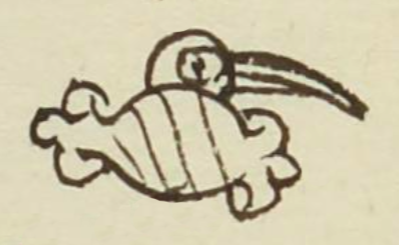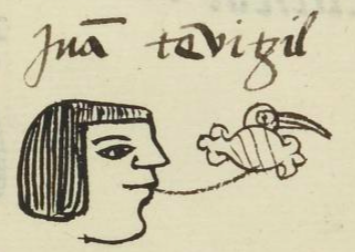Tehuitzil (MH594v)
This black-line drawing of the compound glyph for the personal name Tehuitzil (“Stone-Hummingbird,” attested here as a man’s name) shows a frontal view of a stone (tetl) with curling ends and diagonal stripes. Coming up from behind the stone is the head of a hummingbird (huitzilin) with a long beak. It is in a profile view facing toward the viewer's right.
Stephanie Wood
According to Fernando de Alva Ixtlilxochitl (Obras Históricas, 1985, 493), Tehuitzil (or Tehuitziltzin, in the referential form) was the name of a servant of Nezahualcoyotl (1402–1472). Apparently it was a name that lived on and was in use outside of Tetzcoco.
Stephanie Wood
Juā tevitzil
Juan Tehuitzil
Stephanie Wood
1560
stones, rocks, piedras, hummingbirds, colibríes, chupaflores

te(tl), stone, rock, https://nahuatl.wired-humanities.org/content/tetl
huitzil(in), hummingbird, https://nahuatl.wired-humanities.org/content/huitzilin
Piedra-Colibrí (?)
Stephanie Wood
Matrícula de Huexotzinco, folio 594v, World Digital Library, https://www.loc.gov/resource/gdcwdl.wdl_15282/?sp=268&st=image.
This manuscript is hosted by the Library of Congress and the World Digital Library; used here with the Creative Commons, “Attribution-NonCommercial-ShareAlike 3.0 License” (CC-BY-NC-SAq 3.0).



